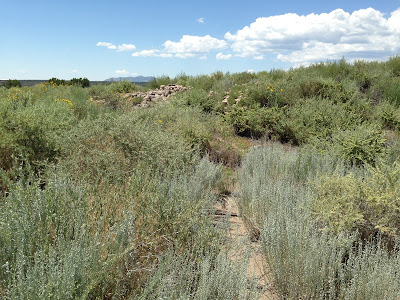 |
| Alien display inside the Roswell International UFO Museum |
There are few places in America emptier than the land southeast along US highway 285 from Santa Fe, New Mexico to
Roswell. Heading south through the sagebrush hills there was Clines Corners, only a store at the I-40 crossing; Vaughn, a once small town dwindling away to only a couple occupied buildings; and Ramon, another town living only from the hotels and gas stations supporting a nearby military base.
Once we crossed I-40, the land flattened and rolled easily into the distance. Endless ups and downs as far as you can see. I found it quiet and peaceful, with the views going on forever. My wife mostly slept.
It is a 192 mile, 3 hour drive, one-way. But we felt we couldn't do any better than take a full day to drive to Roswell and back as it is well south of Denver, and not an area we planned to travel again anytime soon. And we wanted to see the one and only Roswell, site of the first documented and much argued about alien encounter.
 |
| International UFO Museum and Research Center in Roswell, NM |
The Capitan Mountains and Carrizo Peak loomed in the hazy distance to the far right as we drove south. To pass the time we talked about alien encounters and abductions while scanning the sky for anything "unusual".
Roswell seems to be a small, hot and dry town with a Target and a Walmart and a lot of traffic for its size. Actually, over 48,000 people live there. Today the high temperature was 101 degrees, a bit hot. It is home to Eastern New Mexico University and the New Mexico Military Academy, 2 high schools and an airport.
 |
| Little Green Men peek from almost every business in town |
As we drove through town there was an alien theme everywhere you looked. The McDonald's was shaped like a flying saucer, green triangular alien faces looked out from almost every business sign, short alien-shaped statues adorned many more buildings.
 |
| Roswell Radio Station mock-up with a green teletype from the era |
Our goal today was to visit the
International UFO Museum and Research Center in Roswell. It is downtown, right on US 285 on the right side of the street. It appears to be an old theater that has been remodeled to hold the museum exhibits and displays. Once you pay, the tour is self guided and it can take a long time to read everything. The walls are covered with photos and displays, sworn testimonies about what people had witnessed and many pages of denials from different government officials, plus supposedly real government materials about how to handle alien investigations.
 |
| Vintage Western Chicago wire audio recorder (before audio tape was invented) |
 |
| Crash site items with strange writing and metals |
They have a teletype from the era like the one where the news report of the incident was stopped by the FBI, a radio station display with a rare wire audio recorder and a recording of the broadcast of the incident playing at the push of a button. A video theater plays recorded cable television UFO programs all day. An alien site mock-up with fog and lights runs at certain times. Photos cover wall after wall include sightings, various evidence, crops circles, native American art, a prop from the film "The Day The Earth Stood Still", and more. Certainly the people who have donated and collected these things are very serious.
 |
| The Day The Earth Stood Still |
 |
| The great cover-up as the Government denies the alien story |
 |
| Alien photo evidence from around the world |
 |
| Items here include things found implanted in people |
 |
| Crop Circles from around the world |
The Research Center holds a library with reading and study areas and is open to anyone looking to research UFO's.
After our tour we visited an antique mall and the local art museum. The drive back was just as long and empty as the drive here. Eventually we returned to Santa Fe for the night.
Whatever actually happened in Roswell in 1947 may have been so successfully covered up and distorted by our government, we may never know the truth. Roswell is a fun and interesting place to visit and UFO's have become an important part of our American culture.
 |
| Movie props from a 1994 film about Roswell |
To find Roswell, drive south from Santa Fe, NM on US 285 across almost empty land for almost 200 miles. Fill up before you go. It is well worth the trip!









































